Explore the Engineering Marvel of Red Flag Canal: A Journey Through History
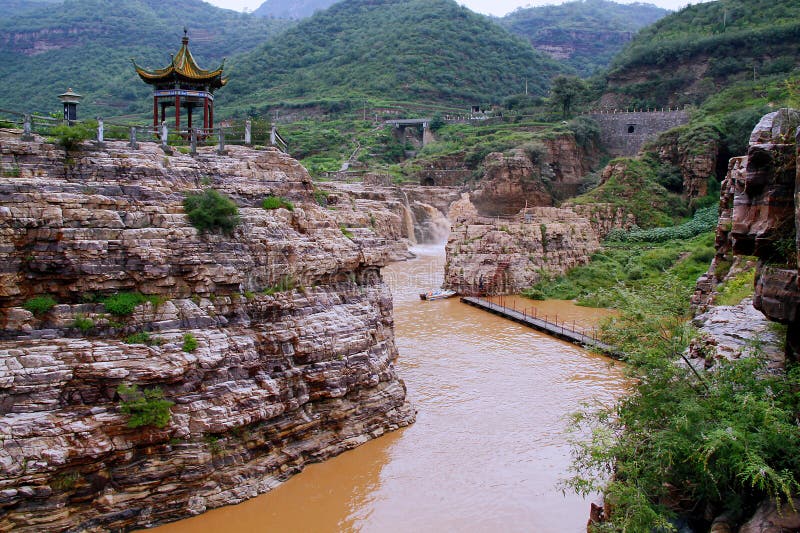
An Essential Guide to Visiting Red Flag Canal
In This Guide
- An Essential Guide to Visiting Red Flag Canal
- The Rich History and Legends of Red Flag Canal
- Main Highlights: What You Absolutely Can’t Miss
- Planning Your Visit: A Practical Guide
- Tickets: Prices, Booking, and Tips
- How to Get There: A Complete Transportation Guide
- Local Cuisine and Accommodation Nearby
- Frequently Asked Questions
- Final Thoughts on Your Trip
Visiting the Red Flag Canal is not merely a journey through picturesque landscapes; it is an expedition into the heart of China’s remarkable history and resilience. Nestled in the rugged terrain of the Taihang Mountains, approximately 20 kilometers north of Linzhou in Henan province, this engineering marvel stands as a testament to human determination and ingenuity. Constructed during the tumultuous era of the Great Leap Forward in the 1960s, the canal was born out of necessity—a response to the frequent droughts that plagued the Linzhou district.
A Legacy of Labor and Innovation
The canal stretches an astonishing 1,500 kilometers, comprising a network of branches that irrigate over 36,000 hectares of land. Its creation was a monumental feat of manual labor, undertaken by thousands of workers who braved perilous conditions—often dangling from cliffs to detonate dynamite with nothing but their courage and ingenuity. The Red Flag Canal transformed the lives of nearly 567,000 people, ensuring a reliable water supply long after its intended lifespan of just 20 years.
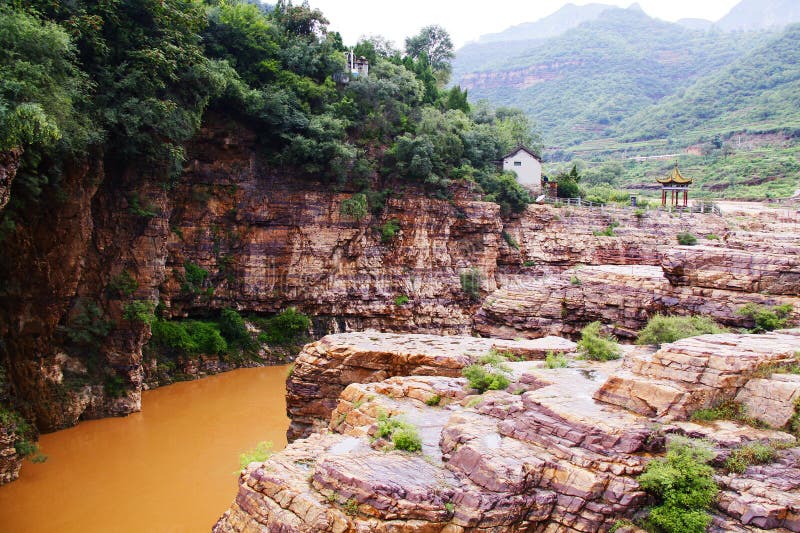
Red Flag Canal.
The Scenic Area: A Journey Through History
Today, the Red Flag Canal Scenic Area offers visitors a unique opportunity to walk along the very channels that once symbolized hope for an entire region. The scenic paths, which wind along cliffs and through tunnels, lead to captivating sights such as the Youth Cave, where the spirit of youthful labor continues to resonate. The Red Flag Canal Museum provides an intimate glimpse into the lives of those who toiled relentlessly, showcasing their stories through poignant photographs and videos.
As you embark on this journey, you will not only witness stunning natural beauty but will also gain insight into a pivotal chapter of Chinese history—a narrative woven with perseverance, community, and the indomitable spirit of its people. Whether you choose to explore for a day or linger for a night or two in the nearby Linzhou area, the Red Flag Canal promises an enriching experience that deepens your understanding of China’s past and present.
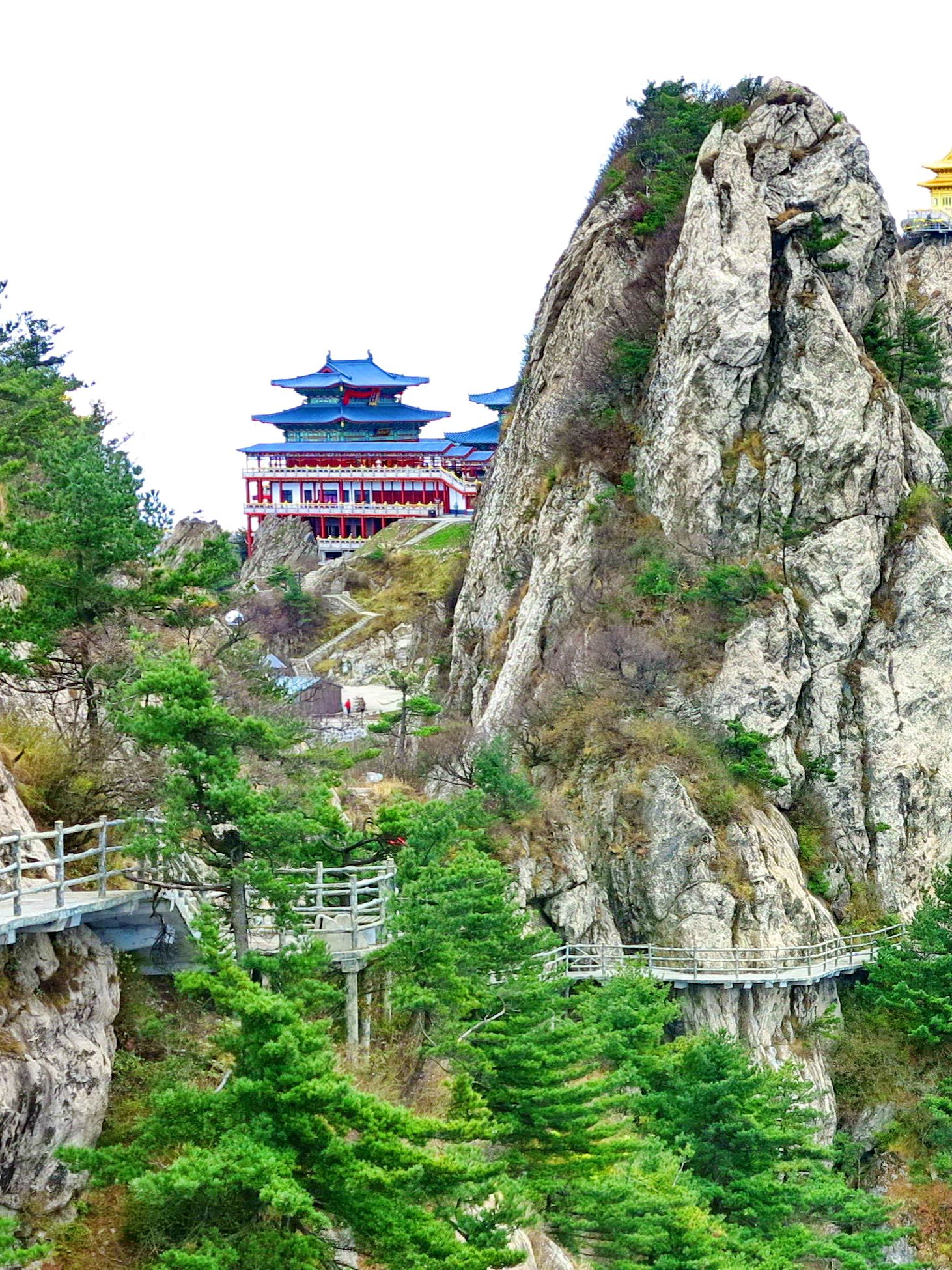
Red Flag Canal.
The Rich History and Legends of Red Flag Canal
The Red Flag Canal, an engineering marvel and symbol of resilience, tells a powerful story that intertwines human determination with the natural landscape. Nestled in the rugged Taihang Mountains of Henan Province, this scenic area stands as a testament to the grit and fortitude of the people who forged it from rock and stone.
A Historical Endeavor
The origins of the Red Flag Canal date back to the era of the Great Leap Forward in the 1960s, a time marked by ambitious and often tumultuous projects aimed at transforming China’s economy. The Linzhou district, frequently plagued by drought, was in dire need of a reliable water source to sustain its agricultural landscape. Thus, the vision of the Red Flag Canal was born.
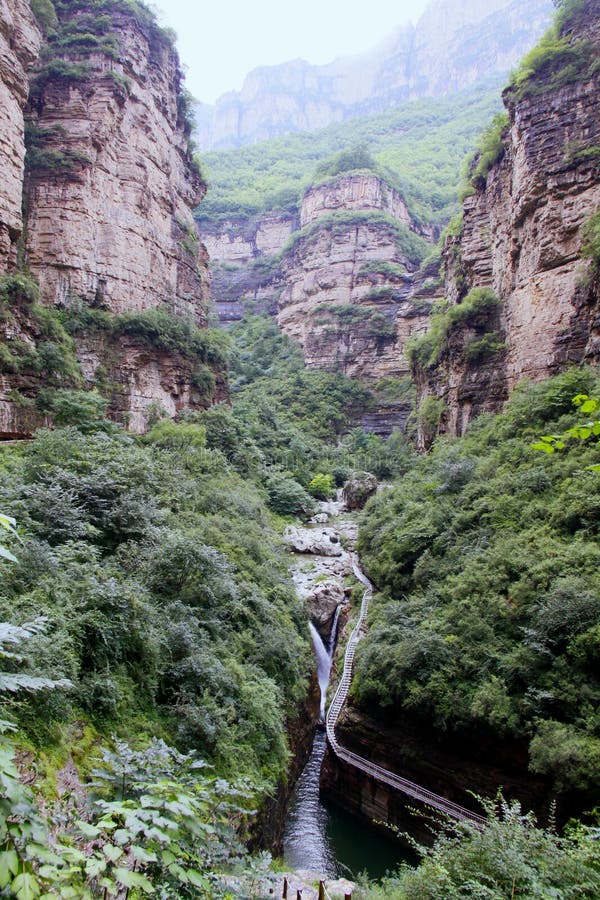
Red Flag Canal.
-
Construction Beginnings: On February 10, 1960, the construction commenced with an initial workforce of 100,000 laborers. However, due to logistical challenges, this number dwindled to about 30,000. With no heavy machinery at their disposal, workers relied solely on their physical strength, using dynamite, chisels, and hammers to carve out a 71-kilometer main channel from the rocky terrain.
-
Labor of Love: The sheer determination of these workers is remarkable. They dangled from ropes to ignite fuses and swiftly hoisted themselves to safety before the explosives detonated. The entire project required the construction of 134 tunnels and 150 aqueducts, ultimately creating a vast irrigation system that spans 1,500 kilometers and serves over half a million people today.
-
Completion and Legacy: The main channel was completed on April 5, 1965, and was initially intended for a 20-year use. However, it continues to function, adapting and evolving to meet the region’s ongoing agricultural needs. Currently, efforts are underway to nominate the canal for inclusion on the UNESCO World Heritage List, recognizing its historical and engineering significance.
Legends and Cultural Significance
The Red Flag Canal is not only a feat of engineering but also a source of local legends and cultural pride that enrich the visitor experience.
-
The Spirit of Youth: One prominent legend revolves around the Youth Cave, a notable section of the canal constructed by 300 young workers. Their commitment is commemorated by the cave’s name, inscribed by the renowned Chinese leader Guo Moruo in 1973. The cave symbolizes youthful vigor and the collective effort of a generation dedicated to transforming their homeland.
-
The Water Guardians: Another legend speaks of the “Water Guardians,” mythical figures believed to protect the canal and its waters. Local folklore often attributes the canal’s continued success to these guardians, who are said to ensure a bountiful supply of water for the fields below. Such tales reflect the deep connection that the community has with the canal and its vital role in sustaining life.
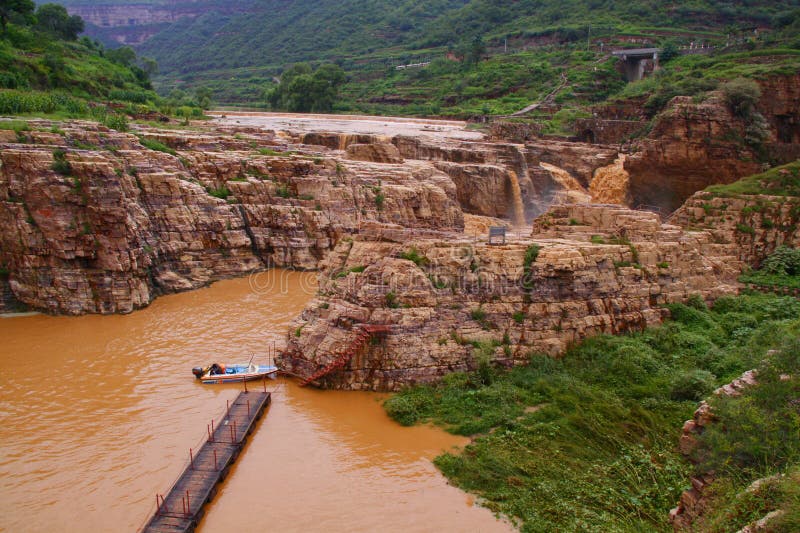
Red Flag Canal.
Visiting the Red Flag Canal
When you explore the Red Flag Canal Scenic Area, you’ll find yourself walking along the main channel, surrounded by breathtaking views of the Taihang Mountains. The Youth Cave, a significant highlight, offers a glimpse into the past where the waters flow through a tunnel carved by the hands of young laborers.
-
Museum Insights: The Red Flag Canal Museum provides an immersive experience, showcasing the stories of the workers through photographs and videos that illustrate their struggles and triumphs. Here, visitors can gain a deeper understanding of the canal’s importance and the spirit of the people who built it.
-
Natural Beauty: Beyond its historical significance, the area is adorned with stunning natural scenery. The Luosi Deep Pool, formed by a semi-circular waterfall, invites visitors to pause and soak in the serenity of the surroundings.
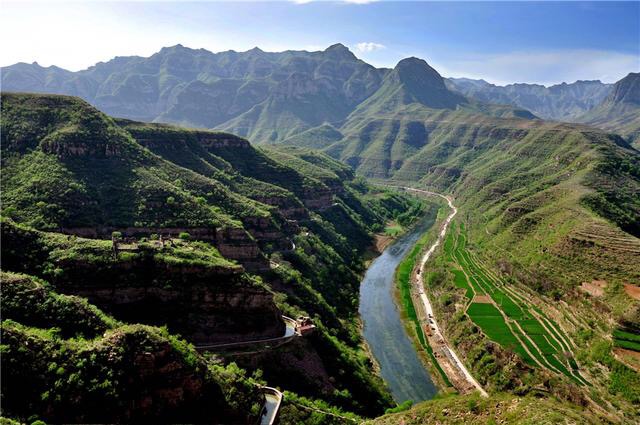
Red Flag Canal.
Conclusion
The Red Flag Canal stands as a monument to human ingenuity and determination. Its history is not merely a recounting of engineering triumphs but a narrative woven with the threads of local legends, cultural identity, and the enduring spirit of the people of Linzhou. For international travelers seeking to immerse themselves in Chinese history and culture, a visit to the Red Flag Canal is not just a journey through time; it is an invitation to witness the resilience and strength of a community that transformed adversity into achievement.
Main Highlights: What You Absolutely Can’t Miss
Discover the Unforgettable Highlights of Red Flag Canal Scenic Area
The Red Flag Canal Scenic Area, nestled in the rugged beauty of the Taihang Mountains in Linzhou, Henan province, stands as a monument to human ingenuity and perseverance. This historical site, born from the ambition of China’s Great Leap Forward era, offers visitors a unique glimpse into the country’s past and its remarkable landscape. Here’s a guide to the main highlights that you simply cannot miss during your visit.
1. The Red Flag Canal Walk
Experience the awe-inspiring main channel of the Red Flag Canal, which stretches 71 kilometers alongside dramatic cliffs and through meticulously carved tunnels. This walkable section provides an intimate view of the canal’s construction—an extraordinary feat accomplished entirely by hand. As you stroll along, you’ll witness how water flows through the rocky terrain, a testament to the laborers’ determination amidst incredible challenges.

Red Flag Canal.
2. Youth Cave
No visit to the Red Flag Canal is complete without exploring the Youth Cave. This 623-meter-long tunnel, constructed by 300 young workers, channels water beneath the mountains. The cave, named by the esteemed Chinese leader Guo Moruo, is not just a passage for the canal; it symbolizes the youthful spirit and dedication of those who toiled to bring this irrigation project to life. The entrance, framed by the rugged mountain landscape, offers a perfect photo opportunity.
3. Red Flag Canal Museum
Located where the main channel splits into three trunk channels, the Red Flag Canal Museum provides a deep dive into the canal’s history. Through captivating displays, old photographs, and personal stories of the canal builders, the museum narrates the challenges faced during construction. This educational experience is included in your entrance ticket and is crucial for understanding the significance of the canal in China’s agricultural development.
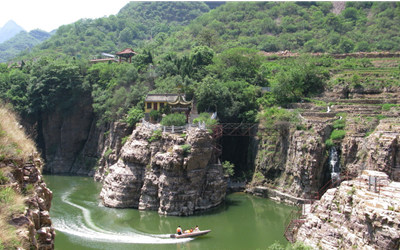
Red Flag Canal.
4. Luosi Deep Pool
Take a short trip to the Luosi Deep Pool, where nature showcases its beauty in the form of a semi-circular waterfall that creates a tranquil deep pool below. This serene spot is perfect for relaxation and reflection. The contrast of the rushing water against the surrounding cliffs makes it an ideal location for photography or simply enjoying the natural scenery.
5. Tigers Mouth Cliff
For the adventurous at heart, the Tigers Mouth Cliff section of the Red Flag Canal offers breathtaking views and a thrilling hiking experience. Here, visitors can enjoy panoramic vistas of the Taihang Mountains and the winding canal below. The dramatic cliffs provide a stunning backdrop, making this a perfect spot for those seeking both adventure and beauty.

Red Flag Canal.
6. Cultural Significance
As you explore the scenic area, take a moment to reflect on the canal’s cultural importance. Initially designed to support irrigation for drought-prone regions, the Red Flag Canal has transformed the lives of over half a million people. Its ongoing use, long beyond its intended 20-year lifespan, speaks volumes about the resilience of the local community and the enduring legacy of the canal builders.
Practical Information
- Opening Hours:
- Winter: 8 AM – 6 PM
- Summer: 8 AM – 9 PM
- Entrance Fee:
- 100 yuan (50 yuan for students, children, and the elderly), which includes access to the Red Flag Canal Museum and Youth Cave.
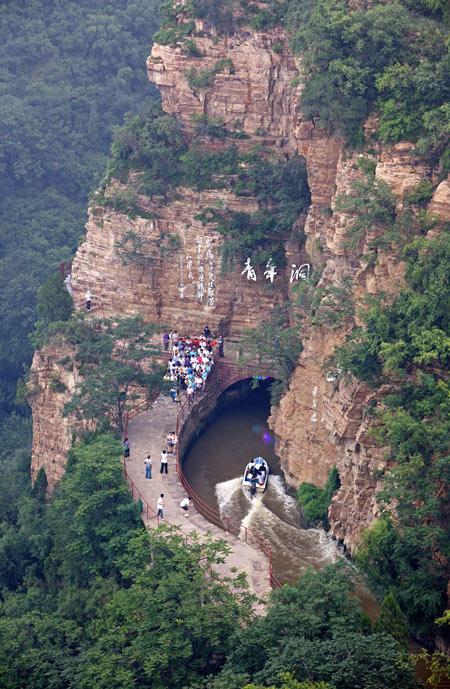
Red Flag Canal.
Getting There
The scenic area is located approximately 20 km north of Linzhou. Most visitors arrive via bus from Anyang, which is about 80 km away. While it may seem remote, the serene environment offers a respite from the busyness of more typical tourist destinations.
Conclusion
The Red Flag Canal Scenic Area is not just a place of historical significance; it is a testament to human resilience and the power of community. Whether you’re walking the canal, exploring the Youth Cave, or simply soaking in the breathtaking views, this destination promises an enriching experience that connects you deeply with China’s remarkable history and culture. Make sure to include this hidden gem in your travel itinerary—an adventure awaits!
Planning Your Visit: A Practical Guide
Essential Information for Visiting the Red Flag Canal Scenic Area
If you’re planning a trip to the Red Flag Canal Scenic Area (红旗渠) in Linzhou, Henan Province, you’re in for a journey steeped in Chinese history and culture. This remarkable engineering feat, constructed during the Great Leap Forward in the 1960s, not only showcases the resilience of its builders but also offers stunning natural beauty. Below is a practical guide to help you make the most of your visit.
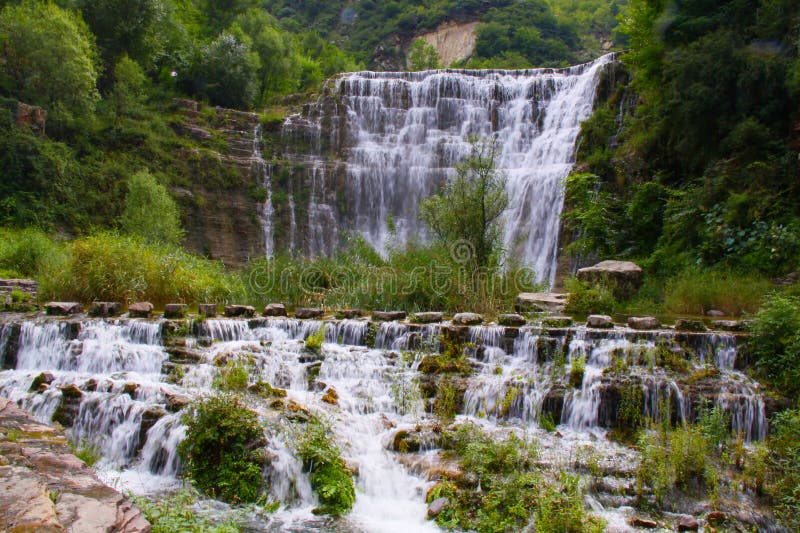
Red Flag Canal.
Opening Hours and Admission
- Winter Hours: 8:00 AM – 6:00 PM
- Summer Hours: 8:00 AM – 9:00 PM
- Entrance Fee:
- Adults: 100 yuan
- Students, Children, and Seniors: 50 yuan
- Admission includes access to the Red Flag Canal Museum, Youth Cave Scenic Spot, and Luosi Deep Pool.
Getting There
The Red Flag Canal Scenic Area is located approximately 20 km north of Linzhou, a city roughly 80 km southeast of Anyang. While the area is relatively remote compared to more popular tourist destinations, it can be reached by various means:
- By Air: The closest airport is Zhengzhou Xinzheng International Airport (CGO), which is well-connected to major cities in China.
- By Train: You can take a high-speed train to Anyang Railway Station or Anyang East Railway Station. From Anyang, you can take a bus to Linzhou.
- By Bus: From Linzhou Bus Station, you can take a local bus or hire a taxi for the 20 km journey to the scenic area.
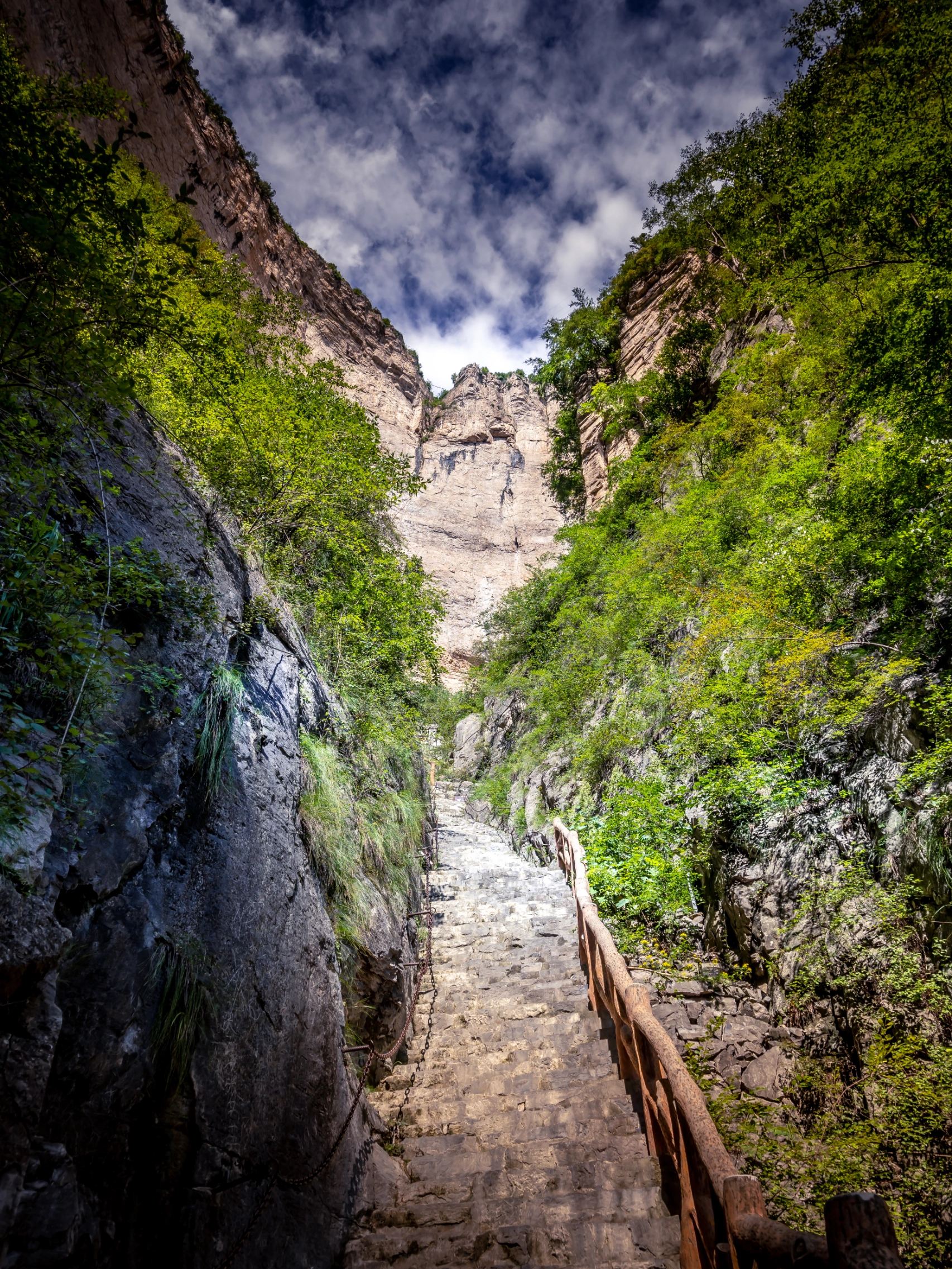
Red Flag Canal.
For your convenience, here’s the address of the Red Flag Canal Scenic Area:
Address:
Red Flag Canal Scenic Area, 225 Taihang Road, Linzhou City, Henan Province, China
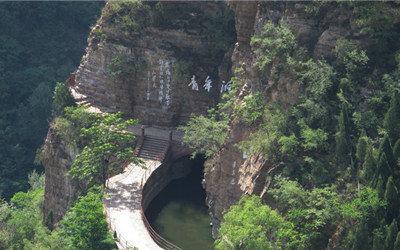
Red Flag Canal.
Recommended Accommodation
Due to the remote location of the Red Flag Canal, your best accommodation options are in Linzhou or the nearby city of Anyang. Here are two highly recommended hotels:
Zhongzhou Yufeng International Hotel (Linzhou)
- Rating: 4 stars
- Distance: 1.69 km from the city center
- Facilities: Free Wi-Fi, fitness center, spa, restaurant, bar, and laundry service.
- Breakfast: Chinese-style breakfast included; extra breakfast available for 25 yuan.
- Travel Tip: It’s advisable to rent a car or negotiate an all-day taxi rate to explore nearby attractions.
Wanda Realm Anyang (Anyang)
- Rating: 5 stars
- Distance: 290 meters from Anyang Museum
- Facilities: Air-conditioned rooms, free Wi-Fi, restaurant, bar, and laundry service.
- Breakfast: Free buffet breakfast typically included.
- Travel Tip: Ideal for those planning to explore attractions in Anyang as well as the Red Flag Canal.
What to See and Do
The Red Flag Canal Scenic Area is rich in historical significance and natural beauty. Here are some must-see highlights:
- Main Canal: Walk along the 71-kilometer-long main channel carved manually through the Taihang Mountains, showcasing the incredible engineering of the canal.
- Youth Cave: Explore the 623-meter-long tunnel constructed by young laborers during the canal’s construction. It’s an inspiring testament to youthful determination.
- Red Flag Canal Museum: Located near the canal’s main channel, this museum offers insights into the canal’s construction through personal stories, historical photographs, and videos.
- Luosi Deep Pool: Take a moment to relax at this picturesque pool formed by a semi-circular waterfall, providing a stunning backdrop for photos.
Tips for Your Visit
- Physical Readiness: While walking along the canal is not overly strenuous, a basic level of fitness is required. Wear comfortable shoes and bring water.
- Best Time to Visit: Consider visiting during spring or autumn for pleasant weather and fewer crowds.
- Cultural Sensitivity: Be respectful of the local customs and the historical significance of the site. Engage with the local guides to enhance your understanding of the canal’s history.
Conclusion
Visiting the Red Flag Canal Scenic Area offers a unique glimpse into China’s revolutionary past and its impressive achievements in engineering. With its stunning landscapes and rich history, it is an experience not to be missed for anyone interested in Chinese culture. Plan your visit thoughtfully, and you’ll create lasting memories in this remarkable part of Henan Province.
Tickets: Prices, Booking, and Tips
Exploring the Red Flag Canal Scenic Area: Ticketing and Travel Tips
Visiting the Red Flag Canal Scenic Area is a journey into China’s remarkable history, showcasing the spirit of resilience and innovation from the Great Leap Forward era. To ensure your visit is smooth and enjoyable, here’s a comprehensive overview of ticket prices, booking options, and travel tips.
Ticket Prices
- General Admission: 100 yuan
- Discounted Tickets: 50 yuan for:
- Students
- Children
- The elderly
These ticket prices grant access to a variety of attractions within the scenic area, including:
– Red Flag Canal Museum: A must-see that narrates the canal’s construction through personal stories and historical exhibits.
– Youth Cave Scenic Spot: A unique geological feature reflecting the hard work of young laborers during the canal’s construction.
– Luosi Deep Pool: A picturesque deep pool formed by a semi-circular waterfall.
Opening Hours
- Winter (November to March): 8 AM – 6 PM
- Summer (April to October): 8 AM – 9 PM
Booking Information
While tickets can often be purchased at the entrance, it’s advisable to plan ahead during peak travel seasons to avoid long waits or sold-out days. For a seamless experience, consider booking a guided tour that includes transportation from nearby cities such as Anyang or a package that covers multiple attractions in the region.
Travel Tips
- Getting There:
- By Bus: From Anyang, take a bus to Linzhou, and then a local bus or taxi to the scenic area (approximately 20 km).
-
By Train: High-speed trains from Zhengzhou to Anyang make for quick access, with connections to Linzhou via bus or taxi.
-
Accommodation:
-
Zhongzhou Yufeng International Hotel in Linzhou is highly recommended for travelers looking for comfort and convenience. It’s located close to the city center and offers free parking, making it a suitable base for exploring the Red Flag Canal.
-
Plan Your Visit:
-
Allow time to explore the Red Flag Canal Museum and the surrounding natural beauty. A day trip is common, but consider staying overnight to fully appreciate the area and its historical significance.
-
Physical Preparedness:
-
The scenic area features walkable paths along the canal, but a basic level of fitness is required, especially for navigating the Youth Cave.
-
Cultural Sensitivity:
- As you explore, take time to reflect on the labor and sacrifice that went into the canal’s construction. Respect the natural environment and historical sites as you journey through this significant landmark.
By following these guidelines, your visit to the Red Flag Canal will not only be educational but also a memorable experience steeped in the rich tapestry of Chinese history and culture. Enjoy the breathtaking landscapes and the profound stories that define this extraordinary site!
How to Get There: A Complete Transportation Guide
Your Guide to Reaching the Red Flag Canal Scenic Area
Visiting the Red Flag Canal Scenic Area offers a unique glimpse into China’s rich history and engineering marvels. Nestled in the northern tip of Henan province, this remote site is not as easily accessible as other tourist destinations in China, but the journey is well worth it. Below, you’ll find comprehensive information on how to get there, ensuring a smooth trip to this historic landmark.
Getting to Linzhou
By Air:
– Zhengzhou Xinzheng International Airport (CGO) is the nearest major airport. From the airport, you can take a taxi or catch a bus to reach Anyang, the closest city with extensive transport options.
By Train:
– Anyang Railway Station and Anyang East Railway Station are the closest rail hubs. High-speed trains from Zhengzhou to Anyang take under an hour, making this a convenient option for travelers. If you’re coming from Luoyang or Xi’an, expect travel times of about 1.5 hours and 2.5 to 3.5 hours, respectively.
From Anyang to Linzhou
Once you’ve arrived in Anyang, you need to continue your journey to Linzhou, approximately 80 kilometers away.
-
By Bus:
Regular buses depart from Anyang Bus Station to Linzhou. The bus ride typically takes around 1.5 hours and is an economical option for travelers. -
By Taxi:
For a more comfortable and faster journey, consider hiring a taxi directly to Linzhou. This option is more expensive but can be more convenient, especially if you’re traveling with luggage.
Reaching the Red Flag Canal Scenic Area
After arriving in Linzhou, you’ll need to make your way to the Red Flag Canal Scenic Area, located about 20 kilometers north of the city.
-
By Bus:
Linzhou Bus Station offers local bus services to the Red Flag Canal Scenic Area. Be sure to check the schedule ahead of time, as service frequency may vary. -
By Taxi:
Taxis are readily available and provide a direct route to the scenic area. This is often the preferred method for visitors, allowing for flexibility in your itinerary. -
Car Rental:
If you prefer to explore at your own pace, renting a car in Linzhou can be a great option. This gives you the freedom to visit other nearby attractions, such as the Linzhou People’s Park and Linzhou Museum.
Recommended Accommodations
Staying overnight in Linzhou can enhance your experience, allowing you to explore the Red Flag Canal and its surroundings without feeling rushed.
-
Zhongzhou Yufeng International Hotel: This 4-star hotel is located near the center of Linzhou, making it a convenient base for your explorations. With amenities like free Wi-Fi, a fitness center, and easy access to local attractions, it’s an excellent choice for travelers.
-
Wanda Realm Anyang: If you prefer staying in Anyang, this 5-star hotel offers luxurious accommodations and is conveniently located near other historical sites. You can easily arrange transportation to Linzhou from here.
Final Tips
-
Entrance Fees: The entrance ticket to the Red Flag Canal Scenic Area is 100 yuan, with discounts available for students, children, and the elderly.
-
Opening Hours: The area is open from 8 AM to 6 PM in winter and until 9 PM in summer, allowing plenty of time to explore.
-
Transportation Services: Local taxi drivers often offer all-day rates for travelers looking to visit multiple sites related to the Red Flag Canal, making it a cost-effective option for those who wish to see more in a single day.
With this guide, navigating your way to the Red Flag Canal Scenic Area should be straightforward. Enjoy your journey through this remarkable part of Chinese history and culture!
Local Cuisine and Accommodation Nearby
Culinary Delights and Comfortable Stays near Red Flag Canal
Exploring the Red Flag Canal Scenic Area is not just about soaking in the breathtaking landscapes and rich history; it also offers a wonderful opportunity to indulge in the local cuisine and find suitable accommodations for a restful night’s stay. Here’s a guide to satisfy both your culinary cravings and lodging needs while you explore this remarkable site.
Local Cuisine to Savor
1. Henan-Style Noodles (河南面条)
– Description: Henan’s signature dish is a must-try. These hand-pulled noodles are often served in a rich broth with an array of toppings such as braised beef, vegetables, and spices.
– Where to Try: Local eateries in Linzhou often serve delicious versions of this hearty dish. Look for small noodle shops bustling with locals for an authentic experience.
2. Steamed Buns (包子)
– Description: These fluffy buns, filled with various ingredients like pork, vegetables, or even sweet fillings, are a popular snack throughout the region.
– Where to Try: Visit street vendors or small restaurants around Linzhou city center for freshly made buns.
3. Yangrou Paomo (羊肉泡馍)
– Description: A unique dish from northwest China, this lamb and bread soup is a warming delight, especially during cooler months. It features shredded flatbread soaked in a flavorful broth.
– Where to Try: Some restaurants in Linzhou may offer this dish, providing a taste of regional variety.
4. Local Vegetables
– Description: Given the proximity to the Red Flag Canal and its irrigation benefits, the local produce is fresh and flavorful. Look for seasonal vegetables served in stir-fries or as sides.
– Where to Try: Restaurants in Linzhou often highlight local ingredients, so be sure to ask for dishes featuring seasonal vegetables.
Recommended Accommodations
Zhongzhou Yufeng International Hotel (中州裕丰国际酒店)
– Rating: ★★★★☆
– Location: Approximately 1.69 km from Linzhou city center.
– Description: This modern hotel opened in 2008 and underwent renovations in 2019, ensuring a comfortable stay with contemporary amenities. Guests can enjoy free Wi-Fi, a fitness center, and a spa for relaxation after a day of exploring.
– Dining: The hotel offers a complimentary Chinese-style breakfast and has an on-site restaurant and bar.
– Accessibility: Free parking is available, making it convenient for travelers with vehicles. The hotel’s proximity to local attractions makes it an ideal base for exploring Linzhou and the Red Flag Canal.
Wanda Realm Anyang (万达瑞华酒店)
– Rating: ★★★★★
– Location: Situated in Anyang, about an hour’s drive from Linzhou.
– Description: As the only 5-star hotel in Anyang, it offers plush accommodations with free Wi-Fi and a range of amenities, including a restaurant and bar. The hotel is close to several cultural sites, making it a convenient choice for travelers wanting to explore the broader area.
– Dining: A free buffet breakfast is typically included in the room rate, featuring both local and international dishes.
Conclusion
Whether you are savoring the local flavors or finding a cozy place to rest, the area surrounding the Red Flag Canal offers a delightful experience for international travelers. Enjoy the rich culinary offerings and comfortable accommodations as you embark on your journey through this remarkable piece of Chinese history.
Frequently Asked Questions
Frequently Asked Questions about Red Flag Canal Scenic Area
1. What are the opening hours of the Red Flag Canal Scenic Area?
- Winter: 8 AM – 6 PM
- Summer: 8 AM – 9 PM
2. How much does it cost to enter the Red Flag Canal?
- The entrance fee is 100 yuan.
- Discounts are available: 50 yuan for students, children, and the elderly. This ticket includes access to the Red Flag Canal Museum, Youth Cave Scenic Spot, and Luosi Deep Pool.
3. What can I expect to see in the Red Flag Canal Scenic Area?
- Visitors can explore the main channel of the canal, the Youth Cave, and various sections that showcase the canal’s historical significance. The Red Flag Canal Museum provides a deep dive into the construction story, featuring personal accounts and historic photographs of the workers.
4. How can I get to the Red Flag Canal from major cities?
- The nearest transport hubs are:
- Airport: Zhengzhou Xinzheng International Airport (CGO)
- Train Stations: Anyang Railway Station and Anyang East Railway Station
- Bus: Take a bus from Anyang to Linzhou, then a taxi to the Red Flag Canal Scenic Area (approximately 20 km).
5. Is it advisable to stay overnight in the area?
- Yes, staying in Linzhou for one or two nights is recommended to fully appreciate the Red Flag Canal and nearby attractions without rushing. The Zhongzhou Yufeng International Hotel is a popular choice for travelers.
6. What is the historical significance of the Red Flag Canal?
- Constructed during the Great Leap Forward in the 1960s, the canal was a monumental labor project aimed at providing irrigation to drought-prone areas. Spanning 1,500 km, it serves as a testament to human ingenuity and determination, having been built without heavy machinery.
7. Are there any physical requirements for visiting the canal?
- While the walkable sections of the canal are generally not arduous, a basic level of fitness and mobility is required, especially for navigating areas like the Youth Cave.
8. Can I book accommodations near the Red Flag Canal?
- Yes, the Zhongzhou Yufeng International Hotel in Linzhou offers comfortable lodging options. Alternatively, you can stay in Anyang at the Wanda Realm Anyang, which provides easy access to transportation options for visiting the canal.
Final Thoughts on Your Trip
As you conclude your exploration of the Red Flag Canal Scenic Area, take a moment to reflect on the remarkable tapestry of history, culture, and human resilience that you have encountered. This extraordinary feat of engineering, born from the toil and determination of thousands, stands not just as a canal, but as a symbol of the spirit of the Chinese people during a transformative era.
Key Takeaways from Your Visit:
-
A Testament to Human Endeavor: The Red Flag Canal represents the indomitable spirit of the workers who carved it from the rugged terrain of the Taihang Mountains, showcasing what can be achieved through collective effort and commitment.
-
Historical Insights: The museum and surrounding sites offer profound insights into the social and historical context of the Great Leap Forward, making it a vital stop for those wishing to understand the complexities of modern Chinese history.
-
Natural Beauty: Beyond its historical significance, the stunning landscapes and serene waters of the canal provide a peaceful retreat, inviting you to connect with nature and appreciate the breathtaking beauty of Henan province.
-
Cultural Connections: Engaging with the local community and exploring nearby attractions, such as the Yin Ruins in Anyang, enriches your understanding of China’s ancient civilization and contributes to a holistic travel experience.
As you depart from this remarkable site, we encourage you to carry the stories of the Red Flag Canal with you. Let them inspire your journey, whether it continues through the rich landscapes of China or leads you elsewhere in the world. Embrace the spirit of exploration, and remember that every destination holds a story waiting to be uncovered. Safe travels!